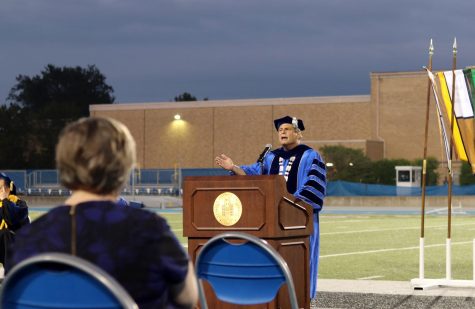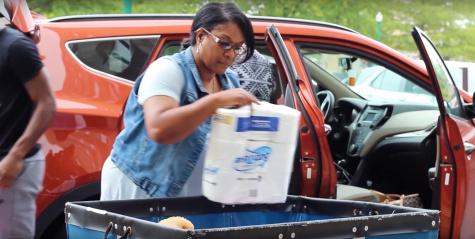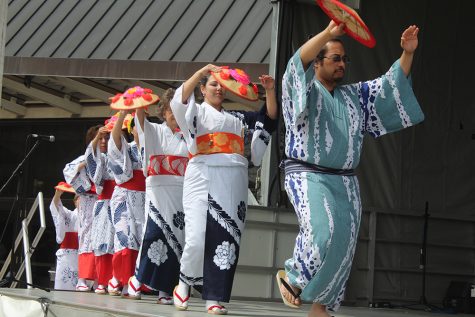Untapped resources in Rec Center
Physical education majors know something the rest of the campus does not.
They are required to use the Assessment and Testing and Prescription Lab in the Student Recreation Center for class.
But other students, faculty and staff can use the lab’s services, including 11 assessments and an exercise prescription, for free.
“Most of the people who just come in on their own. they’re just kind of getting a start on their training program,” said Tasha Thursby, a graduate assistant in the ATP lab.
Although the lab has done about 2,600 assessments in the last semester, only about 20 exercise prescriptions have been requested and given.
Thursby said the lack of clients could be because students do not know about the lab.
Students who come in are tested, and the attending graduate assistant plans a workout routine for them based around their goals, percentages from their one-rep max, bike and flexibility tests, activities the student enjoys and an optional time frame. If a student wanted to lose 5 pounds by spring break and came in three weeks before then, the prescription would be formulated to help that student reach that goal within that period of time, Thursby said.
“Pretty much no prescription is the same,” she said.
Strength training, flexibility and cardiovascular exercises are all components of each prescription.
It is recommended that students change their reps after a certain amount of time, increase their intensity over weeks and months, and come in for additional testing along the way, Thursby said.
However, hardly anyone actually does come back. And because the graduate assistant does not monitor the student’s actual workout behaviors, it is hard to tell if the prescription actually worked, Thursby said.
“You spend so much time on it, but you don’t really know how beneficial it was to the person,” she said.
Students can participate in a number of exercise classes at the rec, play intramural sports, table tennis or foosball, or work out on the available machines.
Exercise classes range from passive activities like yoga and Pilates to more intense classes like advanced abs.
Amy Cummins, a sophomore business education major, enjoys going to exercise classes when they fit into her schedule.
“I think a lot of people just don’t have time or are too lazy,” she said.
Cummins prefers working on her abs, arms and legs, and sometimes focuses on strength training. She attends certain classes when she thinks a certain part of her body needs work.
Other students prefer to get exercise on their own, like Emily Keppler, a junior elementary education major.
Keppler, a resident assistant, makes her trip from Carman Hall to the rec four times per week during cheerleading season to keep in shape. During the rest of the year, she goes about three times per week and works out for about 45 minutes. On nicer days, she runs to and from the facility.
“If I don’t work out, I won’t be able to perform as well (as a cheerleader),” she said.
Outside of cheerleading season, she uses the rec as a stress reliever.
“It keeps my life balanced,” she said.
The SRC’s facilities include treadmills, elliptical machines, stationary bikes, resistance and strength training, free weights, selectorized machines, stretching mats, exercise balls, medicine balls, a stretching cage and a suspended track.
Cummins said her favorite machine is the elliptical.
“You get a full body workout (on it),” she said.
The elliptical machines are the most popular among students, and Eastern has more of them than Western Illinois, Illinois State and Indiana State combined, said Ken Baker, director of the SRC.
Students are fortunate to not have to wait as long to use the machines, he said.
Student fees fund the rec. While other tuition and fees increased a total of $58.90 for fall 2006, the student recreation fee will not change from $69.50 per semester, according to Kevin Linker, director of intramurals.
Western students taking 15 credit hours pay $133.84 per semester for the same fee, according to Western’s campus recreation office.
Other universities spend their money on staff members, whereas Eastern spends it on more equipment, Baker said.
“We’ll bring in equipment, let students try it and see if they like it (before purchasing it),” he said.
Craig Nellum, a junior sociology major and transfer from Western, said he worked out often when he was there. He has not yet made it to the rec in the two semesters he has been here, though, because he said has been busy with classes, work and settling into a new environment.
When he did work out, he preferred cardio exercises, and would usually run two to three miles on Western’s suspended track.
Although Eastern’s fee is lower than Western’s fee, Nellum said it is not worth the money for those who do not use the facilities.
“You should only have to pay if you’re actually going to use the rec,” he said.
Exercise is important because it reduces the risk of chronic diseases, said Stacey Ruholl, assistant physical education professor.
“You start building plaques in your blood vessels at the age of 2,” she said.
The U.S. surgeon general recommends at least 30 minutes of exercise per day.
Dancing, swimming, working out with free weights or various machines, or a number of other activities can achieve a 30-minute workout. It’s something that elevates one’s heart rate and sustains it, beginning with a warm-up and ending with a cool down session, Ruholl said.
For those who do not enjoy working out on machines, whether it is strength training or cardio, intramural sports create outlets for a person to have fun and get exercise all at once.
Intramural sports are extracurricular activities and exercise opportunities for students who are sport-minded and competitive, and for those who want to relive their glory days from high school, said Linker, who is in charge of coordinating Eastern’s intramurals.
There were an estimated 3,000 participants in intramurals this past semester, said Cora Riley, a recreation administration fieldwork student in the rec. Of those, several participated in multiple sports and special events, such as foosball, racquetball, badminton and weird bowling.
Ultimate frisbee, is a good cardio workout, with six players on each team running the length of a football field and taking few to no timeouts, Linker said.
Linker said the department tries to find something new every year, in addition to the sports that have been around awhile, such as flag football, softball and basketball.
When looking for new sports to add, the department distributes surveys to determine student interest in new sports.
One issue with adding a new sport is liability. Linker must determine if the sport is safe enough to add.
“Lacrosse is not an option,” he said.
In light of this, sports such as dodgeball and kickball have been introduced as something different for students to compete in.








































